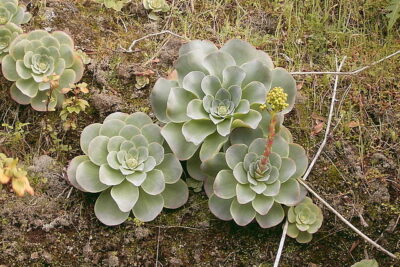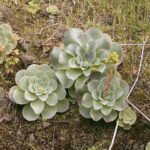
Can Succulents Survive Winter Indoors Without Sunlight?

Succulents are a popular type of plant known for their ability to store water in their leaves, stems, and roots. They are well-adapted to survive in dry and arid environments, making them a favorite among gardeners. However, when winter comes and the days become shorter and darker, many succulent owners wonder if their plants can survive indoors without direct sunlight.
We will explore the topic of whether succulents can thrive during the winter months when kept indoors with limited sunlight. We will discuss the natural habitat and needs of succulents, as well as the importance of sunlight for their growth and survival. Additionally, we will provide some tips and tricks for successfully caring for succulents during the winter, including alternative light sources and adjusting watering habits. By the end of this article, you will have a better understanding of how to keep your succulents healthy and happy throughout the colder months.
- Yes, succulents can survive winter indoors without sunlight
- Provide them with indirect light from a bright window or artificial grow lights
- Place them near a window with south or west exposure for maximum sunlight
- Rotate the plants regularly to ensure even light distribution
- Keep the temperature between 60-75°F (15-24°C) during the day and slightly cooler at night
- Water the succulents sparingly, allowing the soil to dry out between waterings
- Use well-draining soil and pots with drainage holes to prevent root rot
- Avoid placing succulents near heating vents or drafty areas
- Monitor humidity levels and provide adequate air circulation
- Consider using a humidifier or pebble tray to increase humidity if necessary
Yes, succulents can survive winter indoors without sunlight
Succulents are known for their ability to thrive in harsh conditions, including low light levels. While they do prefer bright, indirect sunlight, they can still survive indoors during the winter when sunlight is limited.
However, it is important to note that succulents may not grow as vigorously or maintain their vibrant colors without adequate light. Without sufficient light, they may become leggy, stretched out, and lose their compact shape.
To ensure the survival of your indoor succulents during the winter months, consider the following tips:
1. Place them near a window
Succulents still require some natural light, even if it's not direct sunlight. Choose a bright window that receives the most sunlight during the day and position your succulents near it. South-facing windows tend to provide the most light, while north-facing windows may not offer enough.
2. Use artificial grow lights
If your succulents are not receiving enough natural light, you can supplement their light requirements with artificial grow lights. LED grow lights are a popular choice as they provide the necessary light spectrum for plant growth without generating excessive heat.
 Can Painted Lady Succulents Thrive Indoors?
Can Painted Lady Succulents Thrive Indoors?3. Adjust watering frequency
In winter, succulents generally require less water as they enter a dormant period. Reduced light levels also mean slower growth, which translates to less need for water. Be sure to adjust your watering schedule accordingly and allow the soil to dry out between waterings.
4. Provide proper ventilation
During winter, indoor environments can become dry due to heating systems. Succulents appreciate good air circulation and slightly higher humidity levels. Ensure that your succulents are not placed near heat sources and consider using a humidifier or placing a tray of water near them to increase moisture in the air.
By following these guidelines, you can successfully keep your succulents alive and healthy indoors during the winter, even without direct sunlight. Remember to monitor your plants closely and make adjustments as needed to ensure their well-being.
Provide them with indirect light from a bright window or artificial grow lights
During the winter months, when the days are shorter and natural sunlight is limited, providing succulents with adequate light becomes crucial for their survival. While succulents are known for their ability to thrive in sunny conditions, they can still survive indoors without direct sunlight.
To ensure the well-being of your indoor succulents during winter, it is essential to provide them with indirect light. Placing them near a bright window that receives ample daylight can be beneficial. However, it is important to note that direct sunlight can still be harsh during winter months, so it is best to provide them with filtered or indirect light instead.
If your home lacks a window that receives sufficient sunlight, you can opt for artificial grow lights. These lights are designed to mimic the natural spectrum of sunlight and provide the necessary light energy for plants to thrive. Position the grow lights above your succulents at a distance to prevent burning or overheating.
 Low-Light Succulents: Thriving Office Desk Plants Without Windows
Low-Light Succulents: Thriving Office Desk Plants Without WindowsKey points to remember:
- Indoor succulents can survive winter without direct sunlight.
- Provide them with indirect light from a bright window or artificial grow lights.
- Filtered or indirect light is preferable to avoid damage from harsh winter sun.
- Artificial grow lights can be a suitable alternative if natural light is insufficient.
- Position grow lights at an appropriate distance to prevent burning or overheating.
By ensuring your indoor succulents receive adequate light during winter, you can help them maintain their health and vibrant appearance until the sun shines brightly again.
Place them near a window with south or west exposure for maximum sunlight
Succulents are known for their ability to thrive in dry and arid conditions, making them popular houseplants for those with a busy lifestyle or a tendency to forget to water. However, when winter rolls around and the days get shorter, you may start to wonder if your succulents can survive indoors without sunlight.
The short answer is yes, succulents can survive winter indoors without sunlight, but they may not thrive. Succulents, like all plants, need sunlight to photosynthesize and grow. While they can tolerate lower light conditions, they still require a decent amount of sunlight to maintain their health.
To give your succulents the best chance of survival during the winter months, it's important to place them near a window with south or west exposure. These windows tend to receive the most sunlight throughout the day, even in the winter. Placing your succulents near these windows will ensure that they receive the maximum amount of sunlight available indoors.
It's also worth noting that not all succulents have the same light requirements. Some varieties, such as Echeveria and Sedum, prefer bright, direct sunlight, while others, like Haworthia and Sansevieria, can tolerate lower light conditions. Before bringing your succulents indoors for the winter, do some research to determine the specific light requirements of each plant.
 Tips for Growing Succulents Indoors in Low Light Conditions
Tips for Growing Succulents Indoors in Low Light ConditionsAdditionally, if you live in an area with particularly harsh winters or have limited access to natural light, you may consider supplementing your succulents' light with artificial grow lights. These lights mimic the spectrum of natural sunlight and can be a great way to ensure that your succulents receive the necessary light to survive and thrive.
While succulents can survive winter indoors without sunlight, it's best to provide them with as much natural light as possible. Placing them near a window with south or west exposure will give them the best chance of thriving during the colder months. So, go ahead and find the perfect spot for your succulent collection near a sunny window, and watch them continue to grow and thrive even when the weather outside is frightful!
Rotate the plants regularly to ensure even light distribution
Succulents are known for their ability to thrive in bright, sunny conditions. However, during the winter months, it may be challenging to provide them with the necessary sunlight. Many succulent enthusiasts wonder if these plants can survive indoors without direct sunlight. The good news is that, with proper care, succulents can indeed survive winter indoors without sunlight.
One essential practice to ensure the survival of your succulents during the winter is to rotate the plants regularly. Since they won't be receiving direct sunlight, rotating them will help distribute the available light evenly. This means that each side of the plant will have a fair chance to receive some light exposure.
By rotating your succulents every few days, you can prevent them from leaning or stretching towards the light source. This helps maintain their compact and healthy growth. Remember to rotate them in the same direction each time to ensure even light distribution.
Additionally, if you have multiple succulents grouped together, rotating them will prevent some plants from overshadowing others. This way, all your succulents will have an equal chance of accessing the available light and thriving during the winter months.
 Can Succulent Plants Survive Outside Year-Round?
Can Succulent Plants Survive Outside Year-Round?Keep the temperature between 60-75°F (15-24°C) during the day and slightly cooler at night
Succulents are known for their ability to tolerate a wide range of temperatures, but it's important to keep them within a certain range during the winter months. Aim to maintain a temperature between 60-75°F (15-24°C) during the day, and slightly cooler at night.
Exposing succulents to extreme temperature fluctuations can cause stress and damage to the plants. Avoid placing them near drafts or heat sources, such as vents or radiators, as these can create uneven temperatures and affect their overall health.
Provide adequate lighting
While succulents are known for their ability to thrive in bright, direct sunlight, some varieties can adapt to lower light conditions during the winter. However, it's important to provide them with as much light as possible to ensure their survival.
Place your succulents near a south-facing window if available, as this provides the most sunlight throughout the day. If you don't have access to a well-lit window, consider using artificial grow lights to supplement the lack of natural light.
Water sparingly
During the winter months, succulents enter a period of dormancy where their growth slows down. This means they require less water compared to the warmer months. Overwatering can lead to root rot and other issues, so it's important to water sparingly.
Allow the soil to dry out completely between waterings. Stick your finger into the soil about an inch deep - if it feels dry, it's time to water. Be sure to use well-draining soil and pots with drainage holes to prevent water from sitting in the container.
 Revamp Your Indoor Succulent Garden with Grow Lights: Before and After
Revamp Your Indoor Succulent Garden with Grow Lights: Before and AfterConsider using a humidifier
Indoor environments can become quite dry during the winter due to heating systems. Succulents naturally thrive in arid conditions, but excessively dry air can cause their leaves to dry out and become brittle.
Consider using a humidifier to increase the humidity levels around your succulents. This can help prevent their leaves from drying out and maintain their overall health. Alternatively, you can place a tray of water near your plants to increase humidity through evaporation.
Remember, not all succulents are created equal, and some may have specific care requirements during the winter months. It's important to research the needs of your specific succulent species to ensure they receive the best care possible.
Water the succulents sparingly, allowing the soil to dry out between waterings
Succulents are known for their ability to store water in their leaves and stems, making them excellent plants for dry, arid climates. However, when it comes to surviving winter indoors without sunlight, succulents require a slightly different approach.
The key to keeping succulents alive during the winter months is to water them sparingly. Unlike the summer months when succulents thrive in bright sunlight and warmer temperatures, winter brings shorter days and lower light levels. As a result, succulents enter a period of dormancy where their growth slows down significantly.
During this dormant period, it is crucial to allow the soil to dry out between waterings. Overwatering can lead to root rot, which is a common cause of succulent death. To determine when to water your succulents, simply check the moisture level of the soil by inserting your finger about an inch deep into the soil. If it feels dry, it's time to water.
However, it's important to note that the frequency of watering will depend on factors such as the temperature and humidity levels in your home. In general, succulents require less water during the winter months compared to the summer months. It's better to underwater than to overwater, as succulents can tolerate drought-like conditions more easily than excessive moisture.
 Aerial Roots and Succulent Growth: A Comprehensive Exploration
Aerial Roots and Succulent Growth: A Comprehensive ExplorationProvide supplemental light for your succulents
While succulents can survive in low-light conditions, they will benefit from some supplemental light during the winter months. Without sufficient sunlight, succulents may become etiolated, which means they stretch out and become leggy in their search for light.
Consider placing your succulents near a south-facing window where they can receive a few hours of indirect sunlight each day. If natural light is limited in your home, you can also use artificial grow lights to provide the necessary light for your succulents. LED grow lights are a popular choice as they emit the right spectrum of light for plant growth and are energy-efficient.
It's important to position the grow lights close to the succulents, typically about 6 to 12 inches away, to ensure they receive enough light intensity. Keep the lights on for 12 to 14 hours a day to mimic the natural daylight hours that succulents would receive outdoors during the summer.
Protect succulents from cold drafts and temperature extremes
Another factor to consider when keeping succulents indoors during winter is the temperature. Succulents are native to warm, arid regions and are not tolerant of extreme cold. They prefer temperatures between 60-75°F (15-24°C) during the day and slightly cooler temperatures at night.
Avoid placing your succulents near drafty windows or doors, as cold drafts can cause damage to the plants. Additionally, keep them away from heat sources such as radiators or vents, as excessive heat can also harm succulents. Maintaining a consistent temperature within the ideal range will help your succulents thrive throughout the winter season.
While succulents can survive winter indoors without sunlight, they do require some special care. Water sparingly, provide supplemental light, and protect them from cold drafts and temperature extremes. By following these guidelines, you can ensure that your succulents stay healthy and vibrant throughout the winter months.
Use well-draining soil and pots with drainage holes to prevent root rot
When it comes to succulents, proper soil and drainage are essential for their survival, especially during the winter months when sunlight may be limited indoors. Using well-draining soil is crucial as it helps prevent water from pooling around the roots, which can lead to root rot.
 Can Fuzzy Kalanchoe Succulents Thrive Indoors?
Can Fuzzy Kalanchoe Succulents Thrive Indoors?Opt for a pot with drainage holes, as this allows excess water to escape, ensuring that the soil doesn't become waterlogged. If your chosen pot doesn't have drainage holes, consider adding a layer of gravel or small rocks at the bottom to create a reservoir for excess water to collect.
By providing your succulents with well-draining soil and pots with adequate drainage, you're creating a healthy environment that mimics their natural habitat and increases their chances of survival during the winter months.
Avoid placing succulents near heating vents or drafty areas
If you want your succulents to survive the winter indoors without sunlight, it's important to avoid placing them near heating vents or drafty areas. Succulents are sensitive to extreme temperature changes, and being exposed to hot air blowing from heating vents or cold drafts can cause them stress and even damage their leaves.
Succulents thrive in moderate temperatures, typically between 60-75°F (15-24°C). So, it's advisable to keep them in a room with a stable temperature and away from direct sources of heat or cold air.
Additionally, succulents don't require a lot of water during the winter months as they enter a dormant phase. Overwatering can lead to root rot and other issues. Therefore, it's crucial to adjust your watering schedule accordingly and allow the soil to dry out completely between waterings.
It's also worth noting that succulents need some natural light to survive and thrive. While they can tolerate lower light conditions during the winter, they still need at least a few hours of indirect sunlight each day. If your indoor space doesn't receive enough natural light, you can supplement it with artificial grow lights. These lights provide the necessary spectrum of light for succulents to photosynthesize and grow.
To summarize, here are some key points to remember when trying to help your succulents survive winter indoors without sunlight:
 Choosing the Best Habitat for Thriving Succulents: Indoor or Outdoor?
Choosing the Best Habitat for Thriving Succulents: Indoor or Outdoor?- Avoid placing them near heating vents or drafty areas
- Maintain a stable temperature between 60-75°F (15-24°C)
- Adjust your watering schedule to prevent overwatering
- Provide a few hours of indirect sunlight or use artificial grow lights
By following these guidelines, you can give your succulents the best chance of surviving the winter indoors and continue to enjoy their beauty year-round.
Monitor humidity levels and provide adequate air circulation
When it comes to keeping succulents alive during the winter months indoors, monitoring humidity levels and providing adequate air circulation are key factors to consider. Succulents are known for their ability to tolerate dry conditions, so it's important to recreate this environment as much as possible.
First and foremost, it's crucial to monitor the humidity levels in your home. Succulents thrive in low humidity environments, typically around 40-60%. If the humidity levels in your home are too high, you can use a dehumidifier to bring it down to the desired range. Additionally, you can place a hygrometer near your succulents to regularly monitor the humidity levels and make necessary adjustments.
Adequate air circulation is also essential for succulents. Stagnant air can lead to excess moisture around the plants, which can cause rot and other issues. To ensure proper air circulation, you can place a small fan near your succulent area. This will help in maintaining a dry and airy environment, mimicking the conditions they would typically experience outdoors.
Furthermore, it's important to avoid overwatering your succulents during winter. Since they are not receiving direct sunlight, their growth slows down, and they require less water. Overwatering can lead to root rot and other problems. You can check the moisture level in the soil by sticking your finger about an inch deep into the soil. If it feels dry, it's time to water, but if it still feels damp, hold off on watering for a few more days.
In addition to monitoring humidity and providing air circulation, you can also consider supplementing natural light with artificial light sources. While succulents can survive in low-light conditions for a short duration, they still need some form of light to maintain their health during winter. You can use grow lights specifically designed for plants or fluorescent lights placed near your succulents to provide them with the necessary light spectrum.
By monitoring humidity levels, providing adequate air circulation, avoiding overwatering, and supplementing light, you can increase the chances of your succulents surviving winter indoors without direct sunlight. Remember to observe your plants closely and make adjustments as needed. With proper care, you can enjoy thriving succulents even during the darkest months of the year.
 Indoor Succulents: Thriving Tall Plants for Your Home
Indoor Succulents: Thriving Tall Plants for Your HomeConsider using a humidifier or pebble tray to increase humidity if necessary
When it comes to keeping succulents healthy during the winter months, one crucial factor to consider is humidity. Succulents are native to dry and arid regions, so they are not accustomed to high levels of humidity. However, during winter, indoor environments tend to have lower humidity levels due to heating systems and closed windows.
If you notice that the air in your home is particularly dry, it's a good idea to consider using a humidifier. A humidifier will help increase the moisture in the air and create a more suitable environment for your succulents. Place the humidifier near your plants, but make sure to monitor the humidity levels to prevent over-saturation.
Another option to increase humidity is by using a pebble tray. Fill a shallow tray with water and place pebbles or stones on top. Then, place your succulent pots on the pebbles. As the water evaporates, it will create a humid microclimate around the plants. Just be cautious not to let the pots sit in the water, as this can lead to root rot.
Remember, succulents prefer low humidity, so it's essential to find the right balance. Monitor the humidity levels regularly and adjust accordingly to ensure your succulents thrive during the winter months.
Frequently Asked Questions
Can Succulents Survive Winter Indoors Without Sunlight?
Succulents need sunlight to survive, so it is not recommended to keep them indoors without any sunlight during winter. However, they can tolerate low light conditions for a short period of time.
 Can a Violet Queen Succulent Thrive Indoors? Tips for Indoor Care
Can a Violet Queen Succulent Thrive Indoors? Tips for Indoor CareIf you want to read more articles similar to Can Succulents Survive Winter Indoors Without Sunlight?, you can visit the Indoor and Outdoor Care category.






You Must Read